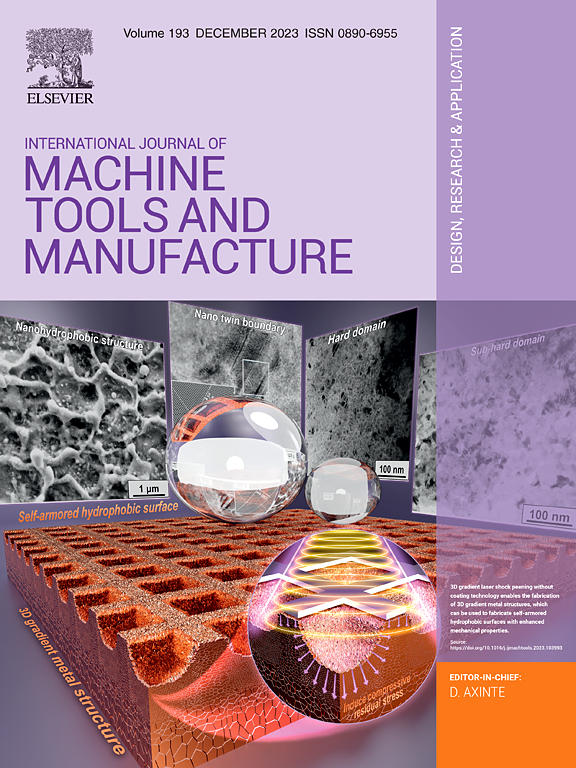Quantitative study of oxidation mechanism in photoelectrochemical mechanical polishing of difficult-to-process semiconductor wafers
IF 18.8
1区 工程技术
Q1 ENGINEERING, MANUFACTURING
International Journal of Machine Tools & Manufacture
Pub Date : 2025-06-27
DOI:10.1016/j.ijmachtools.2025.104307
引用次数: 0
Abstract
The excellent properties of gallium nitride (GaN), silicon carbide (SiC), and diamond make them the most promising semiconductor materials for the future. However, their extremely stable chemical properties and high hardness lead to a low efficiency in chemical mechanical polishing (CMP). Photoelectrochemical mechanical polishing (PECMP) is an efficient and high-quality machining method for difficult-to-process semiconductor materials, integrating photo, electric, chemical, and mechanical fields. However, the coupling of these fields creates complex mechanisms, making it difficult to quantitatively describe the oxidation mechanism driven by the electric field. As a result, selecting the appropriate applied voltage for specific polishing requirements is challenging. To address this, a detailed analysis of the transfer of electrons and holes at the wafer/solution interface was conducted, and an innovative relationship between variations in the energy field and the wafer surface potential in PECMP was established. For the first time, the Poisson equation was applied to the wafer/solution interface, and a novel theoretical model for the oxidation rate and applied voltage on the wafer surface in PECMP was developed. Specifically, at the voltage threshold, the surface charge type changes from electrons to holes, resulting in a significant increase in hole density. Finally, the model was validated through surface modification and PECMP tests. This research not only presents an innovative theoretical method for determining the applied voltage in photoelectric field-assisted polishing for any semiconductor material but also offers new insights into how surface charge transitions between electrons and holes under varying applied voltages can significantly influence polishing efficiency in photoelectric field-assisted polishing.

难加工半导体晶圆光电机械抛光氧化机理的定量研究
氮化镓(GaN)、碳化硅(SiC)和金刚石的优异性能使它们成为未来最有前途的半导体材料。然而,由于其化学性质非常稳定,硬度高,导致化学机械抛光效率低。光电化学机械抛光(PECMP)是一种集光、电、化学、机械等多个领域于一体的高效、高质量的难加工半导体材料加工方法。然而,这些场的耦合产生了复杂的机制,使得难以定量描述电场驱动的氧化机制。因此,为特定的抛光要求选择合适的施加电压是具有挑战性的。为了解决这个问题,我们对晶圆/溶液界面上的电子和空穴转移进行了详细的分析,并在PECMP中建立了能量场变化与晶圆表面电位之间的创新关系。首次将泊松方程应用于晶圆/溶液界面,建立了PECMP中晶圆表面氧化速率和外加电压的理论模型。具体来说,在电压阈值处,表面电荷类型由电子变为空穴,导致空穴密度显著增加。最后,通过表面改性和PECMP试验对模型进行了验证。该研究不仅为确定任何半导体材料的光电场辅助抛光中的施加电压提供了一种创新的理论方法,而且为在不同的施加电压下电子和空穴之间的表面电荷跃迁如何显著影响光电场辅助抛光中的抛光效率提供了新的见解。
本文章由计算机程序翻译,如有差异,请以英文原文为准。
求助全文
约1分钟内获得全文
求助全文
来源期刊
CiteScore
25.70
自引率
10.00%
发文量
66
审稿时长
18 days
期刊介绍:
The International Journal of Machine Tools and Manufacture is dedicated to advancing scientific comprehension of the fundamental mechanics involved in processes and machines utilized in the manufacturing of engineering components. While the primary focus is on metals, the journal also explores applications in composites, ceramics, and other structural or functional materials. The coverage includes a diverse range of topics:
- Essential mechanics of processes involving material removal, accretion, and deformation, encompassing solid, semi-solid, or particulate forms.
- Significant scientific advancements in existing or new processes and machines.
- In-depth characterization of workpiece materials (structure/surfaces) through advanced techniques (e.g., SEM, EDS, TEM, EBSD, AES, Raman spectroscopy) to unveil new phenomenological aspects governing manufacturing processes.
- Tool design, utilization, and comprehensive studies of failure mechanisms.
- Innovative concepts of machine tools, fixtures, and tool holders supported by modeling and demonstrations relevant to manufacturing processes within the journal's scope.
- Novel scientific contributions exploring interactions between the machine tool, control system, software design, and processes.
- Studies elucidating specific mechanisms governing niche processes (e.g., ultra-high precision, nano/atomic level manufacturing with either mechanical or non-mechanical "tools").
- Innovative approaches, underpinned by thorough scientific analysis, addressing emerging or breakthrough processes (e.g., bio-inspired manufacturing) and/or applications (e.g., ultra-high precision optics).

 求助内容:
求助内容: 应助结果提醒方式:
应助结果提醒方式:


